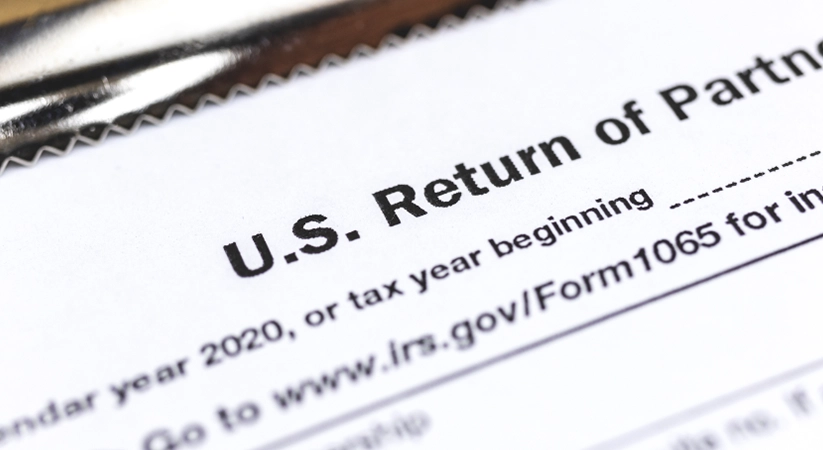Tax Teamwork: Instructions for Partnerships Using Form 1065 on Their Federal Tax Returns
Published:
They say partnership is hard. Then comes along Form 1065.
Before diving into the details of 1065 instructions, it’s important to understand the context behind it. 1065 is an informational tax return form that is used by partnerships, multiple-member LLCs (limited liability companies), and some other types of entities to report their income, deductions, and other tax-related information to the IRS. The form is considered an annual tax form and must be filed every year by the due date, which is usually March 15th.
Definition of Form 1065
Form 1065 is filed annually by partnerships and LLCs to report the income, gains, losses, deductions, and credits. Partnerships and LLCs are not taxed as separate entities, unlike corporations. Instead, the profits and losses of these businesses are passed through to the individual partners or members who report them on their personal tax returns. Form 1065 is used by the business to report these financial transactions to the IRS.
Form 1065 is different from other tax forms in that it is not used to calculate the tax liability of the business. Instead, it is purely an informational return. Once the information is reported on Form 1065, each partner receives a Schedule K-1 that reports their share of the partnership’s income, gains, losses, deductions, and credits. The information from the Schedule K-1s is then used by the individual partners to complete their personal tax returns.
Who Fills Out Form 1065?
Partnerships and LLCs are required to file Form 1065 if they have two or more partners or members. The form must be filed by the 15th day of the third month following the end of the tax year. Form 1065 is intended for businesses that are organized as partnerships, including Limited Liability Partnerships (LLPs) and Limited Liability Companies (LLCs) that have two or more members. Additionally, foreign partnerships that earn income in the United States and non-profit religious organizations that generate gross income of $1,000 or more during the tax year are required to file Form 1065.
Partnerships and LLCs that meet these requirements must report their financial data on Form 1065. This includes total income, deductions, and losses for the tax year, as well as any adjustments made to partners’ capital accounts.
Partnerships are unique in that they do not pay taxes on their profits and losses. Instead, each individual partner is responsible for reporting the appropriate share of the income, deductions, losses and credits on their personal income tax return. The information from Form 1065 is used to generate a Schedule K-1 that is distributed to each partner. The Schedule K-1 reports each partner’s share of the partnership’s financial data for the year and is used to complete the partner’s personal tax returns at the end of the year.
Required Documents
To complete Form 1065, partnerships and LLCs will need to gather certain documents and information. This includes financial statements, such as a balance sheet and income statement, as well as any relevant tax documents, such as W-2s and 1099s. Additionally, partnerships will need to compile information on the partners’ capital accounts, including the beginning and ending capital balances, contributions, distributions and allocations of profits and losses. Being organized and gathering all required documents ahead of time can help streamline the process of completing this informational tax return.
Required Documents:
- Financial Statements
- Tax Documents
- Partner Capital Account Information
What Types of Tax Documents Are Needed to File Form 1065?
If you’re planning to file a Form 1065 for your business or partnership, it’s important to know what types of tax documents are needed to ensure completeness and accuracy. Here’s a list of the necessary documents that should be attached to your Form 1065:
1) Schedule L – This is a balance sheet that details your business’s assets, liabilities, and equity accounts. It’s important to have this document when filing Form 1065 to determine your business’s financial position at the end of the year.
2) K-1 Schedules – Each partner or LLC member must have their own individual K-1 schedule. This document shows their share of the business’s income, deductions, and credits for the year. It’s important to attach this to your Form 1065 to ensure each individual’s tax liability is accurately calculated.
3) Financial Statements – This document provides a comprehensive summary of your business’s financial activities for the year, including income statements and cash flow statements. It’s usually prepared by a certified public accountant (CPA) to ensure accuracy.
4) Loss Statement – If your business incurred a loss during the year, it’s important to attach a statement detailing the loss to your Form 1065. This document helps offset any gains or profits your business made during the year for tax purposes.
5) Personal Tax Returns – Each partner or LLC member should attach their personal tax returns to the Form 1065. This is important in determining their share of the business’s income, deductions, and credits.
What Financial Data Is Necessary for Form 1065?
Form 1065 is an informational tax return form that must be filed by every partnership. It serves to report the business’s income, gains, deductions, losses, and credits for the tax year. Filing Form 1065 is important for the IRS to determine the business’s share of taxable income that passes through to each partner or member, who then report their share of income on their personal tax returns. In order to complete Form 1065 accurately, you must have all of the financial data required by the IRS. Let’s take a closer look at the monetary information needed to complete Form 1065.
Gross Receipts: Gross receipts refer to the total amount of income received by the partnership before any deductions for expenses or taxes are made. On Form 1065, gross receipts are reported on line 1a.
Cost of Goods Sold: The cost of goods sold (COGS) represents the expenses incurred in producing the goods or services sold during the year. On Form 1065, COGS is reported on line 2.
Ordinary Business Income: Ordinary business income refers to all income and expenses generated from the business’s regular operations during the year. This includes revenue from the sale of goods or services and any expenses incurred in producing those goods or services. Ordinary business income is reported on line 1.
Capital Account Balances: Each partner’s capital account balance reflects their investment in the partnership, as well as their share of profits or losses. These balances are reported on Schedule K-1, which is used to report each partner’s share of income, deductions, and credits. The balance sheet should also be included with capital account balances with partners’ share of income or loss.
Schedule L: Schedule L is a balance sheet that reports the partnership’s assets, liabilities, and equity accounts as of the end of the tax year. It is important to have this document when filing Form 1065 to determine the business’s financial position at the end of the year.
Filing Instructions
When it comes to filing Form 1065, it is important to have a good understanding of the instructions to ensure that the process runs smoothly. From gross receipts and cost of goods sold to partners’ capital account balances and Schedule L, there are several key components that need to be considered.
How to Report Distributions on Form 1065
When reporting distributions on Form 1065, it is important to understand that distributions refer to payments made by the partnership to the partners. Such payments may include profits as well as the return of some or all of the partners’ capital contributions. Reporting such distributions accurately requires a clear understanding of the steps involved in the process.
To report distributions on Schedule K-1, it is necessary to use the codes provided in the form. These codes help identify different types of distributions that may be reported, such as cash and property. It is important to note that different distribution types may be taxed differently, hence the significant role that these codes play.
Once the different types of distributions have been identified, it is important to allocate them among the partners accurately. The allocation process may be influenced by various factors such as the partners’ ownership percentages and contributions to the partnership. Accurate allocation is necessary to avoid disputes among partners and ensure tax compliance.
How to Prepare a K-1 Schedule for Partnerships
If you’re operating a partnership, you’ll likely need to file Form 1065, which is an Informational Tax Return. This form is used to report the partnership’s income, deductions, credits, and other relevant items. Partners in the partnership must also file a K-1 Schedule to report their share of partnership income, deductions, credits, and other items.
Here’s how to prepare a K-1 Schedule for Partnerships:
- Verify Partner Information
Ensure that all partner information is accurate and up-to-date. This includes each partner’s name, address, and Social Security number, or other tax identification number.
- Complete Schedule K-1 for Each Partner
Complete a Schedule K-1 for each partner, which reports their share of partnership income, deductions, credits, and other items. The amounts reported should be based on the partner’s ownership percentage in the partnership. Use the relevant codes provided in the Schedule K-1 instructions for reporting different types of income, deductions, and credits.
- Complete Schedule K-1 for the Partnership
Once Schedule K-1 for each partner has been completed, summarize all partners’ shares of income, deductions, credits, and other items on Schedule K-1 for the partnership as a whole.
- Share K-1 with Partners
Provide a copy of the completed Schedule K-1 to each partner to include with their personal tax returns. Partnerships also need to file Form 1065 and attach all completed K-1 Schedules.
How to Prepare a M-1 Schedule for Partnerships
If you are a partnership owner or accountant, preparing an M-1 Schedule is essential when filing the annual tax forms. This form is used to reconcile the partnership’s net income reported on financial statements with the net income reported on the tax returns. Here are the steps to prepare an M-1 Schedule for Partnerships:
- Gather the necessary financial statements and tax returns for the partnership
To prepare an M-1 Schedule, you will need the partnership’s financial statements, which include the balance sheet and income statement, and the tax returns, which include Form 1065 and Schedule K-1.
- Locate the differences between the partnership’s net income on the financial statements versus the net income on the tax returns
The second step is to identify the differences between the net income on the partnership’s financial statements and the net income on the tax returns.
- Input these differences on the M-1 Schedule
Once you have located the differences between the financial statements and the tax returns, input these differences on the M-1 Schedule. These differences should be entered in the appropriate line on the form, using the codes provided in the M-1 Schedule instructions.
- Calculate the total difference between the net income on the financial statements and the tax returns
After inputting the differences on the M-1 Schedule, calculate the total difference between the net income on the financial statements and the tax returns. This amount should be entered on Line 11 of the M-1 Schedule.
- Transfer the amount to Line 1 of the M-1 Schedule
Finally, transfer the total difference amount from Line 11 of the M-1 Schedule to Line 1. This will reconcile the partnership’s net income on the financial statements with the net income reported on the tax returns.
Sources
“2022 IRS Form 1065 Walkthrough | Partnership Tax Return” – A Penny Pinchers Guide to Personal Finance



